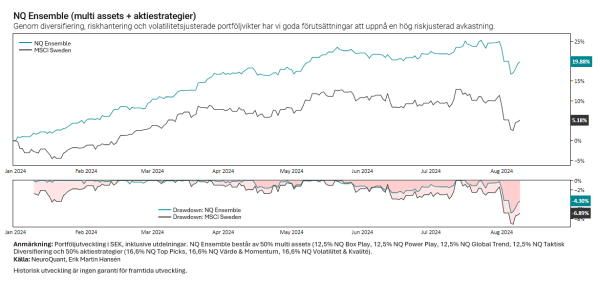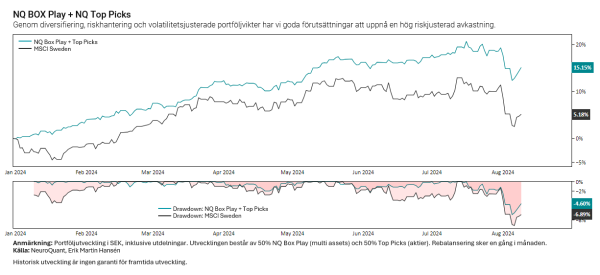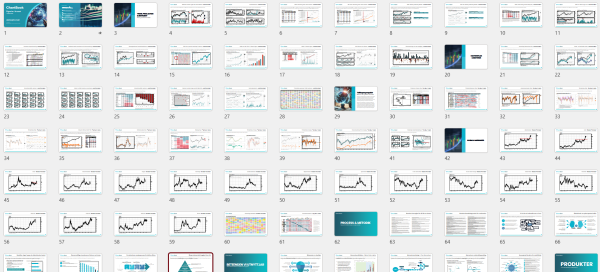Weekly report: Ensemble of strategies

The weekly report provides signals from the noise. We summarize models and strategies, and try to decode the market's message with a scientific approach to stay on the right side of the larger trends.
In this edition:
- Market update
- Development of portfolios/strategies
- ChartBook (PDF) with observations, statistics and developments
Market update
During the week, volatility has decreased in major asset classes and the stock market has recovered from the oversold situation.
It is not a given that a market will bounce back from an oversold position, as markets can sometimes crash from oversold territory.
Earlier this week, however, I highlighted some signals in a blog post who spoke for a rebound.
“I wouldn’t be surprised if the stock market bounces back and volatility subsides. Let’s not forget that it’s an election year in the US, which creates incentives from multiple quarters to support the economy.” – blog post, August 6, 2024
The conclusion in the blog post was more of a subjective assessment of the market. We do not have any systematic strategies that buy on oversold conditions when the trend in the Trend & Trade Range model is neutral or negative. The trend filter in the TTR was negative and is still negative.
Login required to view graph.
Not a customer? Open an account to access our analytics service.
Will the market roll over to the downside again?
Many are wondering whether the market will lose its footing in the current upswing and once again roll over to the downside, or whether volatility will remain low and the stock market will continue to recover.
Most investors and traders love to speculate about what will happen in the future. Few players prefer to trade simple systematic strategies with a focus on following rules.
Login required to view graph.
Not a customer? Open an account to access our analytics service.
Breakdown-signal i OMXS30!
OMXS30 has given a signal in the 100-Day Breakdown, which means sell/short in TF System 2 (read more in Trend Following PDF). In the strategy, entry occurs at the 200-day high and exit occurs at the 100-day low. If we trade long/short, we take a position for both the rise and the fall.
Login required to view graph.
Not a customer? Open an account to access our analytics service.
Development of global markets last week:
- OMXS30: -0.3% (+4.3% from Monday's low)
- VIX-Index: -12,9%
- Dollar Index: -0,1%
- Ishares Commodity Index ETF: +0,8%
- Wisdomtree Softs: +1,8%
- Xetra-Gold ETC: +0,1%
- XACT Obligation: -0,1%
- Bitcoin Zero Valour: -5.3% (+20% from Monday's low)
Development strategies/portfolios
According to ChatGPT, an ensemble involves collaboration and interaction between systems and models used to achieve the same goal.
Let's look at the performance of a portfolio (ensemble) that consists of 50% of our multi-asset strategies and 50% of our equity strategies. I balance within the groups and rebalance once a month.
 NQ Ensemble has risen by 19.9% YTD. This compares with 5.2% for the stock market (MSCI Sweden). The return for the collection of strategies has been higher than the stock market at a lower volatility and maximum drawdown.
NQ Ensemble has risen by 19.9% YTD. This compares with 5.2% for the stock market (MSCI Sweden). The return for the collection of strategies has been higher than the stock market at a lower volatility and maximum drawdown.
The idea is not to own all the portfolios as it would be very time consuming to administer them. We get a lot done with, for example, 50% Box Play (multi assets) and 50% Top Picks Momentum (equities).
 If you want to take additional risk, we can, for example, add a layer of trading strategies on top, such as long/short trend following or equilibrium swings according to Trend & Trade Range.
If you want to take additional risk, we can, for example, add a layer of trading strategies on top, such as long/short trend following or equilibrium swings according to Trend & Trade Range.
How we put together an investment process is very individual. We all have different circumstances, risk tolerance and goals. I just want to give some inspiration.
Development of multi-asset strategies last week
- NQ Box Play: -0,4%
- NQ Power Play: -0,8%
- NQ Tactical Diversification: -0.9%
- NQ Global Trend: -0.5%
Development of model portfolios (stocks) last week
- NQ Top Picks Momemtum: +0,8%
- NQ Value & Momentum: +0.4%
- NQ Volatility & Quality: +0.5%
Download ChartBook
Account required to download ChartBook. Not a customer? Open for free demo account to test our service.
Have a nice weekend!
Erik Martin Hansen
Frequently Asked Questions (FAQ)
What time perspective are you focusing on?
We focus on swing trading (a few days to a few weeks) and position trading (weeks, months or even years). Within these strategies we can either trade with or against the direction of the trend. The premise is that the best signals are in the direction of the long-term trend, which is driven by fundamental factors and macroeconomic conditions.
What are systematic strategies?
Systematic trading is based on predefined rules for how we should act, which reduces the risk of emotional decisions affecting trading. The rules can be tested to give us an idea of how they have performed under different market conditions. By acting systematically, we follow data instead of our intuition or gut feeling.
What does it mean to act discretionarily?
Decision-making is informed by a range of influences. Intuition and experience are used to navigate the market. Discretionary players often seek excitement and are interested in buying signals and “cases” for quick money. They often have overconfidence in their ability to spot the right company or time the peaks and bottoms of the market. If we only act on emotion and draw impressions from a range of influences, the results will be erratic. There is a risk that we will jump between different strategies, act impulsively and without careful consideration.
What are the benefits of systematic strategies?
One advantage of trading systematically is that we can follow strategies consistently without deviations and thus generate more consistent results over time. We strive to be objective and methodical instead of irrational players like many others in the market. A complete market player knows that discretionary decisions are sometimes required, but has managed to eliminate emotions from the decision-making process.
Is it possible to time the market?
There are many simple methods to avoid major declines. There are also many working methods for short-term trading. What doesn't work is forecasting the future. Those who claim to consistently spot tops and bottoms are charlatans and liars. The main focus should not be on buying bottoms and selling tops, but instead on decoding the direction the market is taking and positioning ourselves accordingly. We want to be in tune with the market and listen to its messages. Constantly trying to buy bottoms and tops is often based on a desire to be more insightful than everyone else. A more workable attitude is to let the market show us the way.
How do you view technical analysis?
We do not use the subjective technical analysis that many consider technical analysis, such as support and resistance levels, formations, head/shoulders patterns, wave theories, Gann, magic numbers, etc. There is a reason why successful market participants ignore these methods. We focus on things that can be quantified. Since everyone has access to price data and there is a lot of free information out there, much of the technical analysis is useless if you want to make money over time. Beginners spend a lot of time on entry and exit and various signals that should work according to technical analysis. Professional players spend a lot of time and resources on diversification, risk and position management.
How do you view macro?
Macro tells us what the market should do, while price analysis and positioning tell us what the market actually does. Macro is particularly useful at major inflection points. We assume that growth and inflation affect how investors view different markets, sectors and factor styles. If we can get this data right, we can get a lot of other things right. That said, it can be very challenging. It’s about filtering out the noise and being patient. What the market does in the short term has nothing to do with macro. We use a regime-based framework for the coming quarters that helps us create order in what might otherwise be seen as chaos. We know what tends to go well and poorly in the different market regimes, which helps us, but it’s not a surefire answer.
How do you view momentum?
Momentum is a well-documented anomaly. Momentum has worked for the past 100 years and we assume that the effect will persist because investor behavior does not change, regardless of new technological or other changes. Momentum is not a strategy that suits everyone, and that is also one reason why momentum strategies work over time. The same applies to value strategies. There is an edge or advantage, but far from everyone is able to follow the strategy and thus reap the rewards. With a systematic strategy, you have a better chance of success. We believe in the concept and assume that momentum will continue to beat the index over time. It is important that we are disciplined and have patience. There will be long periods where momentum or other types of strategies perform weaker.
